The Ultimate Illusion Propping Up Your Dream-State
Part 1: Introduction – The Conventional Understanding
Alright, let’s talk about death.
Not the spooky, Halloween-mask, scythe-wielding caricature, nor the hushed-tone, tiptoe-around-the-subject-lest-we-jinx-ourselves version that polite society prefers.
No, let’s talk about the death that sits in the back of everyone’s mind, the one that shapes decisions, fuels anxieties, and underpins a vast architecture of belief and denial. This is the death of the common man, the death of the nightly news, the death that sells insurance and inspires tear-jerker movies. It’s the grand, unspoken agreement that this whole shebang – this life, this self, this experience – has a definitive, and rather grim, expiration date.
The conventional wisdom, the one you absorbed with your mother’s milk and had reinforced by every funeral and every biology textbook, is pretty straightforward: you are born, you live, you die. And death? Death is the end. The cessation of being. The lights go out, the music stops, the party’s over. It’s the ultimate full stop. For some, this is a terrifying abyss of nothingness. For others, it’s a gateway to something else – a fluffy-cloud heaven, a fiery hell, a karmic spin on the cosmic roulette wheel for another go-around. But even these hopeful addendums are built upon the fundamental premise that this particular iteration of ‘you’ comes to a screeching halt.
This understanding of death isn’t just a passive observation; it’s an active ingredient in the human drama. It’s what gives life its supposed preciousness, its urgency. “Live every day like it’s your last,” they say, because, well, one day it will be. It’s the bedrock of grief, the justification for legacy-building, the quiet terror that drives people to accumulate, to achieve, to be remembered. If death weren’t the perceived end, would anyone bother trying to leave a mark? Would the concept of a life’s work even exist? The entire structure of meaning, for many, is propped up by this looming specter of annihilation. We define ourselves against it, live in defiance of it, or resign ourselves to its inevitable victory. It’s the ultimate boogeyman, the final boss, the one appointment everyone, supposedly, has to keep.
This, in a nutshell, is the death that the world sells you, the death that underpins the dream-state. It’s a foundational assumption, rarely questioned, deeply embedded. And it’s precisely this version of death, this universally accepted ‘truth,’ that we’re going to put under the microscope.
Not to offer a more comforting alternative, not to replace one set of beliefs with another, but to see if it holds up under scrutiny. Because in the world of radical nonduality, the things everyone knows to be true…
…are often the first things to crumble.
The Unmappable Territory We Keep Trying to Chart
Part 2: Mapping the Territory – Multiple Perspectives
So, we’ve established the baseline: death is the big, bad wolf at the door, the ultimate party pooper.
But humanity, in its infinite and often misguided ingenuity, hasn’t just sat quivering in the corner. Oh no. We’ve poked it, prodded it, dressed it up in fancy clothes, and tried to make sense of it from every conceivable angle.
This is the part where we take a quick tour through the labyrinth of human thought on the subject – the various maps we’ve drawn of this supposedly dark continent. Spoiler alert: none of them lead to buried treasure, but they do reveal a lot about the mapmakers.
Historically, our understanding of death has been a real rollercoaster. One minute we’re burying our dead with their favorite snacks and a spear for the afterlife journey, the next we’re mummifying them to preserve the fleshy vehicle for a cosmic reboot. Then along comes science, all white coats and clipboards, telling us it’s just biological cessation, a predictable breakdown of the machinery. The narrative shifts, but the underlying anxiety, the desperate need to know and to control, remains a constant. Each era, each culture, slaps its own coat of paint on the same old fear, hoping this time the color will make it less terrifying or more meaningful. From elaborate sky burials to stoic acceptance, from ancestor worship to the clinical sterility of a modern hospital death, the rituals and beliefs are a testament to our species-wide obsession with this one, inevitable event.
And it’s not just a historical fashion show. Look across cultures today, and you’ll find a dizzying array of perspectives. Some Eastern traditions might talk about reincarnation, the soul hopping from one life-costume to another, learning lessons along the way. Western thought, heavily influenced by Abrahamic religions, often leans towards a one-shot deal followed by eternal reward or punishment. Then you have indigenous cultures with intricate cosmologies where death is a transition, a rejoining with the ancestors or the land. The details vary wildly, but the theme is consistent: death is a thing that happens, a process to be navigated, a state to be understood or transcended. Everyone’s got a theory, a system, a way of coping. It’s a global potluck of eschatological ideas, each claiming to have the secret recipe.
Science, of course, wades in with its own brand of certainty. Death, from the empirical standpoint, is when the heart stops beating, the brainwaves flatline, the cells cease their metabolic dance. It’s observable, measurable, definable – up to a point. They can tell you how the body dies, catalog the stages of decomposition with chilling precision. But what death is, in any experiential or existential sense, remains stubbornly outside the reach of their instruments. The scientific approach offers a detailed autopsy report but leaves the ghost in the machine entirely unaddressed. It describes the container, but says nothing about the contents, or the absence thereof.
Then there are the psychologists, the cartographers of the inner landscape. For them, death is a major player in the psyche. It’s the root of existential angst, the driver of defense mechanisms, the catalyst for grief and mourning. The Kübler-Ross model gives us neat stages – denial, anger, bargaining, depression, acceptance – as if the profound mystery of obliteration can be tidily packaged into a five-step program. Fear of death, they tell us, shapes our personalities, our relationships, our societal structures. It’s the ultimate motivator, the ultimate source of neurosis. We build identities, seek meaning, and cling to relationships, all in a desperate bid to buffer ourselves against the chilling realization of our own impermanence. Death, in this view, isn’t just an event; it’s a psychological force field that warps everything around it.
So, there you have it – a whirlwind tour of the conventional maps of death. Historical, cultural, scientific, psychological – each offers a different lens, a different interpretation. And yet, for all this intellectual and emotional effort, for all these elaborate systems and comforting narratives, does anyone really feel like they’ve got a handle on it?
Or is it more like a collective whistling past the graveyard, a desperate attempt to chart a territory that, by its very nature, might be unchartable? These maps, for all their detail, might just be intricate drawings…
…of the bars of our own conceptual prison.
When The Self That Dies Is Already An Illusion
Part 3: Dismantling the Structure – Deconstructive Analysis
Alright, so we’ve had our little tour of the intellectual theme park that humanity has constructed around the concept of ‘death.’
We’ve seen the historical exhibits, the cultural dioramas, the scientific explanations, and the psychological self-help aisles. It’s all very… human. We build these elaborate structures, these conceptual frameworks, to make ourselves feel better, to create a sense of order in a universe that, frankly, doesn’t seem to give a damn about our need for neat little boxes.
But what if we start pulling at the threads of these constructions? What if we apply a little pressure, a little critical thinking, a little… deconstruction? What happens when the carefully curated museum of ‘death’ starts to crumble?
First, let’s look at the foundational assumptions. The big one, the elephant in the room, is the idea of a separate, individual ‘self’ that is born, lives, and then, poof, dies. This ‘I’ that we cherish, this collection of memories, experiences, preferences, and anxieties – we assume it’s a solid, continuous entity. But is it? Or is it more like a story we tell ourselves, a constantly shifting narrative woven from fleeting thoughts and sensations? If the ‘self’ is an illusion, a construct, then what exactly is it that dies? Can an illusion cease to exist? Or was it never really there in the first place?
Then there’s the language we use. Words like ‘death,’ ‘end,’ ‘loss,’ ‘afterlife’ – these are all loaded terms, packed with cultural and emotional baggage. We use them without thinking, as if they represent some objective reality. But language doesn’t just describe reality; it shapes it. By using these words, we reinforce the very concepts they represent. What if we were to step outside this linguistic prison? What if we were to acknowledge that our words are just pointers, crude approximations of something that might be far more complex, or far simpler, than our vocabulary allows? The moment we label something, we limit it. The moment we say ‘death,’ we’ve already confined it within the cage of our existing understanding.
Let’s turn the mirror on ourselves: how much of who we think we are exists in direct response to death? We strive, we achieve, we accumulate, often driven by a desire to leave a mark, to be remembered, to somehow transcend our own finitude. Our fear of death, our resistance to it, paradoxically gives our lives a certain kind of meaning, a certain kind of drama. What if we were to let go of that? What if we were to see that the ‘I’ that fears death is itself a fleeting phenomenon, a temporary pattern in the vastness of existence? Would the fear still hold the same power? Or would it be seen as just another thought, another sensation, passing through?
And what about our belief systems? Religions, philosophies, spiritual traditions – they all have something to say about death. They offer explanations, consolations, promises of what lies beyond. But are these systems designed to reveal truth, or are they designed to manage fear? Are they a way of confronting reality, or a way of escaping it? If we strip away the dogma, the rituals, the comforting narratives, what are we left with? Perhaps just the raw, unadorned fact of change, of transformation, of the constant arising and passing away of forms.
When we start to expose the contradictions, the whole edifice begins to look rather shaky. We fear the unknown, yet we cling to beliefs about death that are, by their very nature, unknowable. We mourn the loss of a loved one, yet we acknowledge that all things are impermanent. We seek to prolong life, to cheat death, yet we know that every moment is a step closer to it. These are not logical paradoxes to be solved; they are pointers to the limitations of our conceptual frameworks. They reveal the cracks in the walls of our self-constructed reality.
Finally, let’s not forget the emotional attachments. Fear, grief, anxiety, hope – these are powerful emotions that color our perception of death. They are real, in the sense that we experience them. But are they accurate reflections of reality? Or are they conditioned responses, learned patterns of thought and feeling? What if we were to observe these emotions without judgment, without identifying with them? What if we were to see them as simply energy, arising and passing, like clouds in the sky? Would death still hold the same emotional charge?
Deconstructing death isn’t about finding new answers or replacing one set of beliefs with another. It’s about questioning the very foundations upon which our current understanding is built. It’s about seeing the assumptions, the language, the identities, the belief systems, and the emotional attachments for what they are: constructs, stories, illusions. And when the illusions begin to fall away, what remains? Perhaps something far more simple…
…and far more profound, than we ever imagined.
The Phantom Ending to an Illusory Self
Part 4: The View from Nowhere – Nondual Perspective
So, we’ve taken a sledgehammer to the flimsy stage set of conventional death.
The props are smashed, the backdrops are torn, and the actors are looking rather bewildered. Good. Deconstruction is fun, like a toddler with a tower of blocks, but it’s not the end game – it simply clears the space.
Now, what, if anything, stands in that cleared space when we talk about this thing called ‘death’ from a perspective that isn’t playing by the usual rules of self and other, subject and object, existence and non-existence? Welcome to the view from nowhere, which is, paradoxically, the view from everywhere and right here.
Let’s get one thing straight: from the standpoint of Absolute Truth – if you’ll forgive such a grandiose term for something that’s ultimately wordless – there’s no such thing as death. How can there be? Death, as we conceive it, requires a ‘someone’ to die and a ‘something’ for them to die from or into. But if the fundamental reality is a seamless, undivided wholeness, if there is no actual, independent, separate self to begin with, then who is doing the dying? What is there to cease? The wave crashes on the shore, and we call it the death of the wave. But the wave was never anything other than ocean in the first place. The ocean doesn’t mourn the wave; from the ocean’s perspective, nothing has fundamentally changed. It’s just ocean being ocean, in a temporary form called ‘wave,’ and then in a form called ‘not-wave.’ All appearance, all manifestation, is just the play of this one, indivisible reality. Death, in this light, is a misperception, a category error born from the illusion of separation.
This is the No-Self Perspective in action. If there’s no enduring, solid ‘me’ at the center of experience, then the fear of ‘my’ annihilation becomes… well, absurd. It’s like fearing the death of a character in a dream. The character isn’t real in the way you think it is. Its ‘death’ is just a shift in the dreamscape. When the dream ends, the character doesn’t go anywhere; it simply ceases to be a feature of the dream. The ‘you’ that you take yourself to be, this bundle of thoughts, memories, and sensations, is much the same. It’s a temporary pattern. Its dissolution isn’t a tragedy; it’s just the pattern dissolving. What remains? The awareness in which the pattern appeared. And that awareness isn’t personal. It isn’t ‘yours.’ It just is.
This brings us to the crucial distinction between Truth and Truthiness. The lowercase-t truth is that bodies cease to function. Hearts stop. Brains go dark. We experience grief. These are observable phenomena in the relative world, the world of appearances. But capital-T Truth isn’t concerned with appearances in the same way. It points to the underlying reality that is untouched by the coming and going of forms. The mistake is to confuse the two, to take the relative truth of bodily cessation as the ultimate truth about existence or non-existence. I’m not telling you to deny the reality of a corpse. I’m telling you to look unflinchingly at what it means, and what it doesn’t mean, from a place of radical honesty, stripped of comforting beliefs and spiritual platitudes.
So, what happens when we go beyond conceptual frameworks? When we drop all the stories, all the labels, all the beliefs about death, what’s left? Not a new concept, not a better explanation. What’s left is the direct, unmediated reality of this. And ‘this’ is not something that can be captured in words. Death, as a concept, is a product of thought. When thought is quiet, when the conceptual mind isn’t constantly trying to frame and interpret experience, what is there to be afraid of? What is there to be ‘dead’? There is just the unfolding of presence, moment by moment. The attempt to understand death conceptually is like trying to catch the wind in a net. The real understanding, if we can call it that, lies in seeing through the net itself.
The concept of death plays a vital dreamstate function. It’s one of the main pillars supporting the illusion of a separate self. The fear of ‘my’ death reinforces the sense of ‘me’ as a distinct, vulnerable entity. It keeps us locked into the drama of survival, the pursuit of security, the avoidance of pain. It’s a powerful tool for maintaining the dream of separation. When you start to see through the illusion of the separate self, the concept of death begins to lose its terrifying power. It’s seen as part of the dream, not an ultimate reality that governs it.
Ultimately, from this perspective, death, like all phenomena, has an empty nature. This doesn’t mean it’s nothing, in a nihilistic sense. It means it’s empty of inherent, independent existence. It doesn’t exist on its own, separate from the consciousness in which it appears as a concept or an event. It’s an appearance, a thought, a story. And like all stories, it can be seen through.
The relentless scrutiny of ‘what is death?’ leads not to an answer, but to the dissolution of the questioner and the question itself…
…into the silent, unnameable reality that is all there is, and all there isn’t.
Authentic Presence When Death Loses Its Sting
Part 5: Practical Considerations – Living Truth
So, the grand edifice of ‘Death’ as a terrifying, personal annihilation has been reduced to rubble.
The separate self that was supposed to die has been exposed as a phantom. Reality, from this nondual vantage point, is an undivided, seamless whole, and ‘death’ is just another concept, another appearance within it.
Great. Now what? How does one live with this, assuming ‘one’ is even the right word anymore? Does this mean we float around in a blissed-out state, immune to the sight of a hearse or the news of a friend’s passing? Not quite. This isn’t about acquiring a new superpower; it’s about seeing through a fundamental delusion.
Let’s be brutally honest. The implications for daily engagement with what appears as death are… subtle, and yet profound. When you see a body cease to function, when grief arises in response to the apparent loss of a loved one, the nondual understanding doesn’t magically erase these experiences. The body still stops. Grief still feels like grief. The difference lies in the identification. The pain is there, but the story of ‘my pain,’ ‘my loss,’ ‘their tragic end’ begins to lose its grip. There’s a recognition that what is appearing is an expression of life, of change, of the constant flux of forms. The suffering that arises from resisting this flux, from clinging to the idea of permanence and separateness, starts to diminish. You don’t stop caring; you stop contracting around the caring.
How does this understanding shift behavior, fear, and attachment? Well, if death isn’t the ultimate personal catastrophe, then the frantic, fear-driven pursuit of security, legacy, and self-preservation at all costs starts to look a bit… silly. The energy that was once consumed by fearing the end can be liberated for living now, not as a desperate race against time, but as an unfolding of what is. Attachments to outcomes, to people, to one’s own precious identity, loosen. Not because you become cold or indifferent, but because you see that what you’re attached to are temporary forms, not the underlying reality. The fear of death is, at its core, the fear of the unknown, the fear of losing the known ‘me.’ When the ‘me’ is seen as a construct, the fear loses its primary target.
What, then, is the “appropriate response” to death from a place of radical honesty? There isn’t a prescription. There’s no nondual handbook for how to behave at funerals. The appropriate response is the authentic response that arises in the moment, free from the conditioned obligation to perform grief or to deny the reality of what’s appearing. It might be tears. It might be silence. It might be a profound sense of peace. The key is honesty – an unflinching look at what is, without the overlay of shoulds and shouldn’ts. If there’s sadness, it’s just sadness. If there’s fear, it’s just fear. These are appearances, not proof of the ultimate reality of death as an end.
Of course, there are common pitfalls and misunderstandings. One is nihilism: “If nothing is real and I don’t exist, then nothing matters.” Wrong. This is just another conceptual trap. Nonduality isn’t about denying the relative reality of experience; it’s about seeing its ultimate nature. Another is spiritual bypassing: using nondual concepts to avoid genuine human emotion or responsibility. “Oh, it’s all just an illusion, so their suffering doesn’t matter.” That’s not understanding; that’s callousness dressed up in spiritual jargon. And then there’s the trap of mistaking intellectual understanding for realization. You can read all the books, nod along to all the talks, but if the core identification with a separate self remains untouched, you’re just collecting more concepts.
The paradox of apparent death in a nondual reality is where many get stuck. “But people do die! I’ve seen it!” Yes, forms change. Bodies cease to function. This is undeniably true on the level of appearance. The nondual perspective doesn’t negate this; it reframes it. The wave disappears, but the ocean remains. The character in the dream vanishes, but the dreamer (or the dream itself, if we want to get really slippery) continues. The apparent death of a form is not the death of Reality. It’s a shift within Reality.
This is where we must address experiential objections. The grief is real. The sense of loss is real. The fear can feel overwhelmingly real. The nondual perspective doesn’t ask you to pretend these experiences aren’t happening. It asks you to investigate their nature. Who is experiencing this grief? What is this fear made of? When you look closely, without judgment, you begin to see that these experiences, however intense, are temporary states arising and passing within a vast, unchanging awareness. They are not you, and they are not the final word on what is true.
Imagine this: you’re watching a movie. A beloved character dies. You feel sadness, maybe even cry. Does this mean the character was ‘real’ in the same way you are? Does it mean the actor who played the character has actually ceased to exist? No. You’re responding to a story, an appearance. The emotional response is real, but the underlying reality is different.
Living with the nondual understanding of death is something like that – acknowledging the play of appearances, feeling the human responses, but knowing, at a deeper level, that the ultimate reality is untouched, unthreatened, and ever-present. It’s not about not feeling…
…it’s about not being fooled by the feeling into believing a story that isn’t true.
The Ultimate Non-Event in the Theater of Consciousness
Part 6: Conclusion – Beyond Conclusions
So, here we are, at the end of this little exploration into what we call ‘death.’
We’ve poked it, prodded it, dressed it up, and stripped it bare. We’ve looked at it through the lens of convention, deconstruction, and something that tries to point beyond all lenses. And what have we learned? Perhaps nothing. Perhaps everything. Perhaps the very act of trying to ‘learn’ about death is like trying to bottle the sky – a futile exercise in human arrogance.
If you came here seeking definitive answers, a neat little package of understanding to carry away, you’re likely disappointed. This isn’t a self-help guide to dying gracefully, nor is it a philosophical treatise that will win you points at your next dinner party (unless your dinner parties are far stranger than mine). This was an invitation to question, to dismantle, to look beyond the comfortable narratives we’ve inherited or constructed.
The truth about death, if there is such a thing, isn’t found in words on a page, or in the pronouncements of sages, or even in the most profound intellectual gymnastics. These are all just signposts, fingers pointing at the moon. Don’t mistake the finger for the moon. Don’t mistake the map for the territory. The territory, in this case, is you, your experience, your awareness. And the map? Well, we’ve just been scribbling on it, haven’t we?
What if death isn’t an event that happens to you, but rather a shift in perspective within you? What if the fear of death is simply the fear of the unknown, the fear of losing the illusion of control, the fear of the ego dissolving back into the vastness from which it arose? What if the entire drama of life and death is a play of consciousness, a cosmic dance of form and emptiness?
These aren’t questions with easy answers. They aren’t meant to be. They are meant to unravel the neat little bows with which we tie up reality. They are meant to disturb the comfortable slumber of certainty.
So, what now? Do you go back to your life, a little more confused, perhaps a little less certain about the things you thought you knew? Good. Uncertainty is the gateway to understanding. Doubt is the chisel that chips away at the hardened edifice of belief.
Don’t take my word for any of this. Don’t take anyone’s word for it. Look for yourself. Question everything. Question the questioner. What is this ‘I’ that is so concerned with its own beginning and end? What is this awareness that witnesses the unfolding of life and the prospect of death?
The final punchline isn’t a punchline at all. It’s an echo, a reverberation in the space you’ve hopefully cleared by reading this. The journey isn’t over; it has, perhaps, just begun. Or maybe it never started, and it will never end. It just is.
And that, perhaps, is all that needs to be said about death…
…or anything else, for that matter.





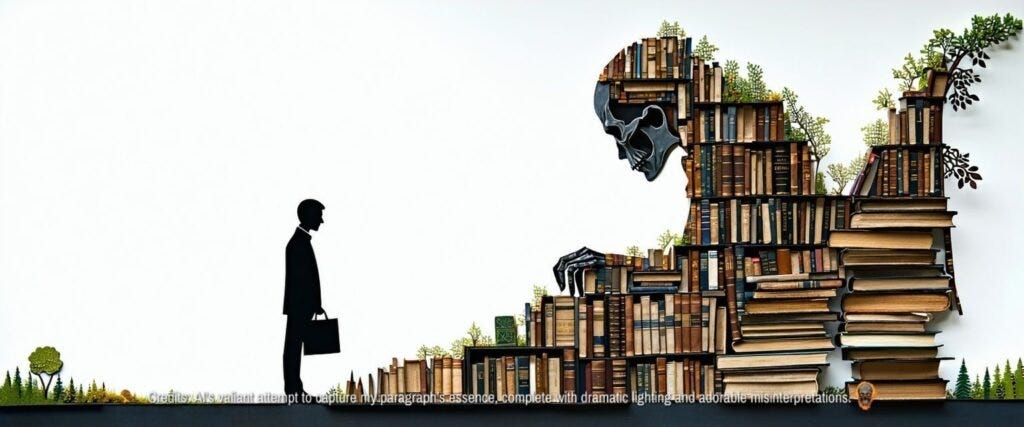
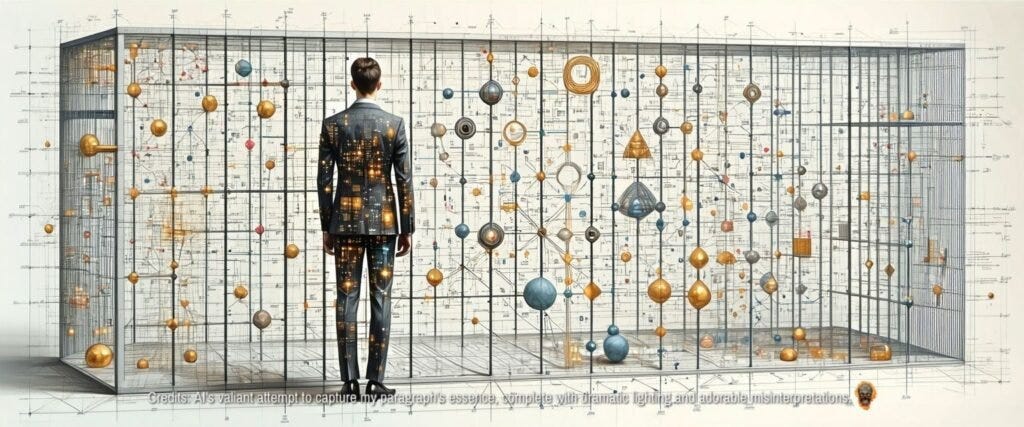
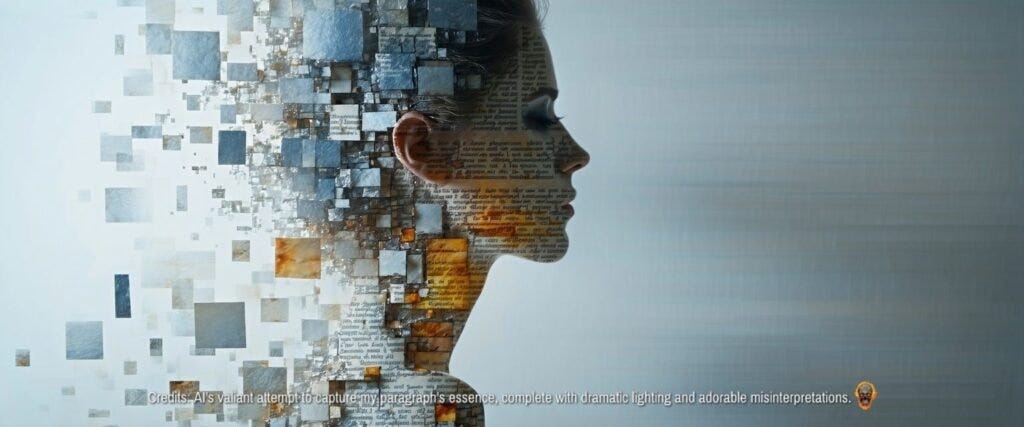
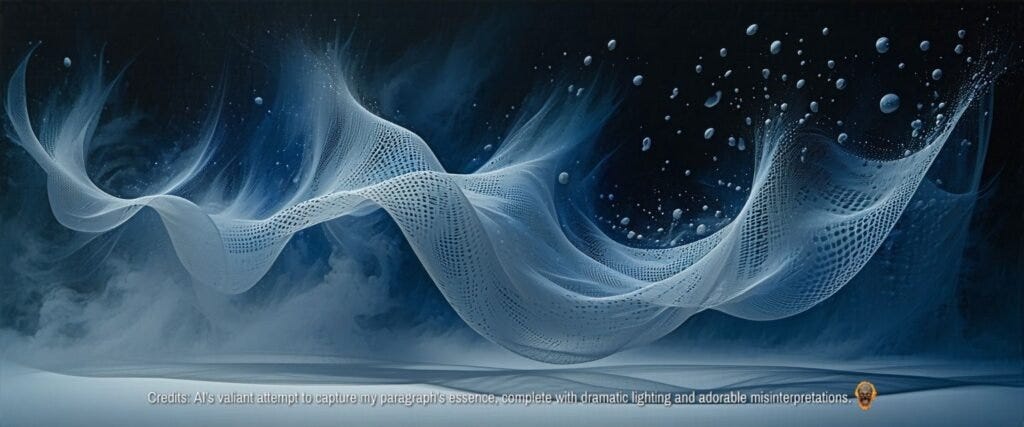
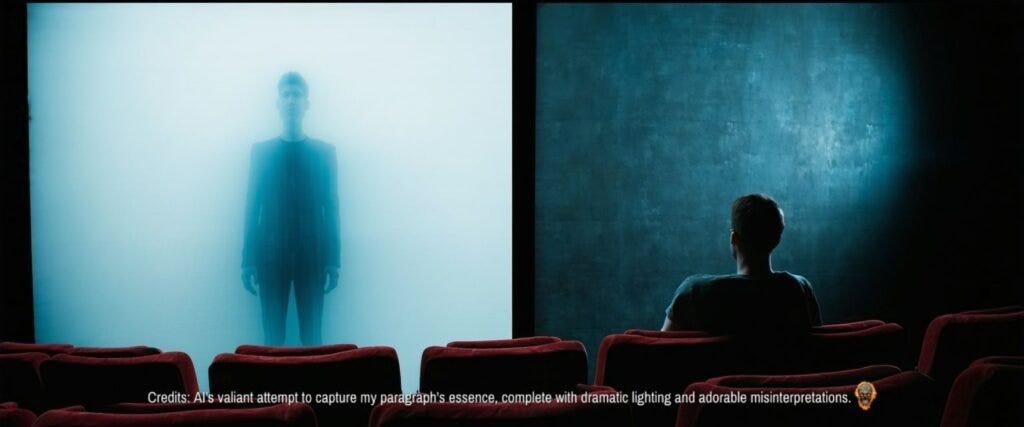

From Nothingness to Nothingness. Beyound this Nothing.
Very helpful and clarifying. Strangely encouraging. Thank you.